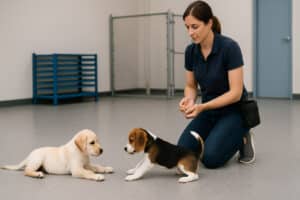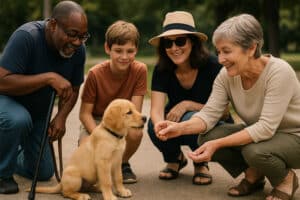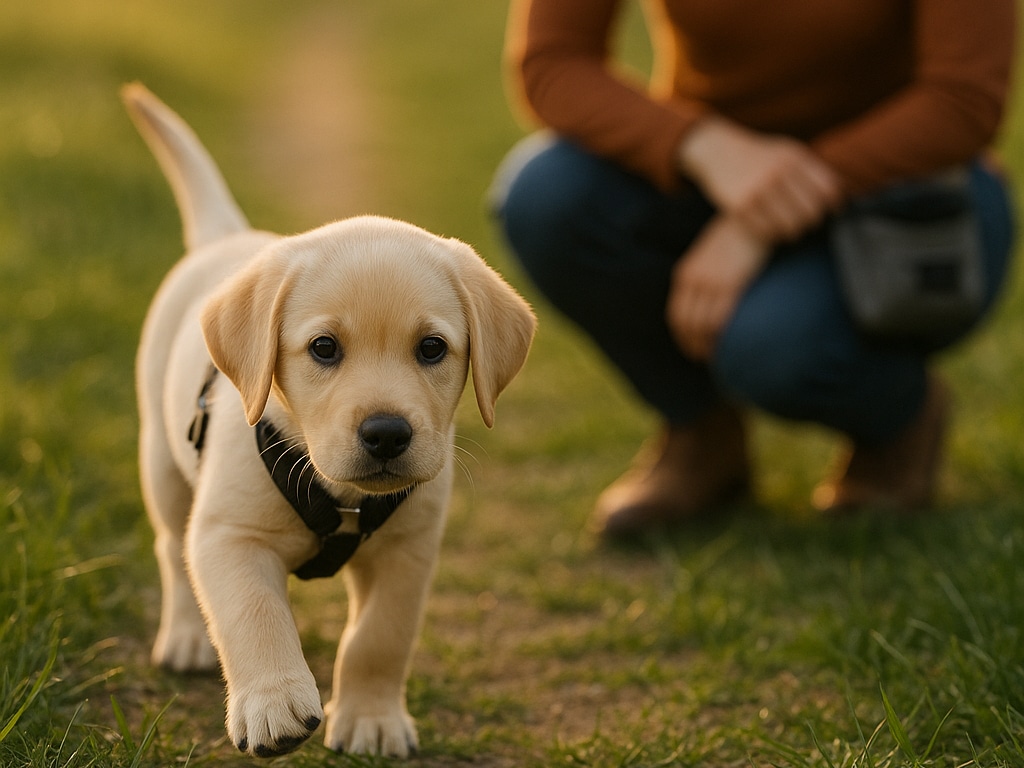Every dog’s behaviour as an adult can be traced back to one defining window of time: the critical period of socialisation. It’s a brief and powerful phase in a puppy’s early life that lays the foundation for how they perceive and respond to the world. At K9 Principles, we’ve guided countless dog owners through this essential stage—and seen firsthand how early social experiences can either build a confident, resilient dog or create a fearful, reactive one. If you want your puppy to grow into a stable, emotionally balanced companion, this isn’t a step you can afford to overlook. It’s not optional. It’s urgent. This is where great dog training begins.
What Is the Critical Period in Puppy Development?
The critical period is a unique stage in brain development that happens when a puppy is most open to learning about the world in a safe and meaningful way. During this time, their brain is wired to absorb new experiences without hesitation, judgment, or fear. This is not about obedience or formal dog training—it’s about exposure. Puppies that are carefully and positively exposed to a variety of environments, people, sounds, animals, and textures during this stage are significantly more likely to develop into dogs that can handle new experiences with calm curiosity instead of fear.
Biologically, this period is when neural connections related to learning and social development are forming rapidly. Puppies that are isolated or under-exposed during this window often grow into adults who struggle with fear-based behaviours, hyper-vigilance, and reactivity. Once the window closes, the brain becomes more cautious. New things can start to seem threatening instead of interesting. You’re no longer socialising at that point—you’re retraining.
When Does the Puppy Socialisation Period Begin and End?
The critical socialisation period begins at around three weeks of age and typically ends by sixteen weeks. While every dog is slightly different, the most intense and influential time occurs between three and twelve weeks. This is when puppies are most flexible, curious, and unafraid. From a behavioural perspective, it’s like a sponge stage—your puppy is absorbing everything you show them and quietly filing it away under either “safe” or “scary.”
That means breeders play a critical role in the early phase—before the puppy ever comes home. The handover to new owners typically happens around eight weeks, meaning the responsibility to continue structured, positive exposure falls to you for the final and most formative half of this window. That’s why your actions between eight and sixteen weeks can literally change the trajectory of your dog’s entire life.
Why Early Socialisation Matters More Than You Think
Puppies that aren’t given rich, positive experiences during this period don’t “catch up” on their own. In fact, dogs who miss this stage often develop anxiety around novelty, including new people, dogs, environments, and sounds. These are the dogs who can’t cope with visitors, who bark at every car, or who panic in unfamiliar settings. It isn’t their fault—they simply weren’t given the emotional blueprint during the one time their brain was open to it.
Socialisation at this stage builds emotional resilience. A well-socialised puppy learns, “I’ve seen this before and nothing bad happened.” That’s the seed of confidence. It’s how you future-proof your dog’s behaviour and prevent fear-based reactivity before it starts. The value of this can’t be overstated. Preventing a behaviour problem is always easier—and more humane—than trying to fix one later.
What Puppies Should Experience During This Critical Window
Let’s be clear: socialisation does not mean chaos. It’s not a checklist of loud, overstimulating situations or wild interactions with every dog and stranger you can find. It means calm, controlled exposure to a wide variety of normal life situations—done in a way that’s positive, safe, and tailored to your puppy’s comfort level. At K9 Principles, we guide every client through this with intention and structure.
People and Human Behaviour
Your puppy should meet a wide range of people: children, adults, people with facial hair, glasses, hats, mobility aids, and different ethnic backgrounds. Let them observe people talking, walking, clapping, laughing. The goal isn’t to overwhelm your dog with handling—it’s to teach them that people of all types are normal, not threatening. Gentle interactions paired with food rewards create positive associations that last a lifetime.
Environments and Situational Exposure
Puppies need to learn that the world is big, and that they’re safe within it. Start small: your street, your garden, a quiet park. Work up to walking near roads, visiting shops, or entering lobbies. Different flooring, lighting, smells, and traffic sounds should all be introduced. Use treats and a calm tone to help your puppy associate these changes with safety. The more they see early, the less likely they are to fear it later.
Sounds, Surfaces, and Novel Stimuli
The vacuum cleaner. The microwave. A truck passing by. Rain on the roof. These sounds may seem minor to you, but to a puppy with no context, they can be overwhelming. Gradually exposing your dog to these sounds—while calmly rewarding and giving space—can prevent sound sensitivities later. Don’t forget textures too: grates, carpet, gravel, tiles, sand. Dogs who’ve only walked on grass are often unsure in buildings or city settings.
Safe Dog-to-Dog Interactions
Your puppy’s dog experiences need to be positive, not chaotic. That means choosing well-socialised adult dogs or enrolling in carefully supervised puppy classes—not just letting your dog interact with every off-lead stranger at the park. One bad experience during this phase can create a lasting fear or reactivity. At K9 Principles, we facilitate calm, educational dog-to-dog greetings where puppies learn polite boundaries, canine body language, and how to disengage when needed.

The Role of Positive Reinforcement During Socialisation
Every new experience should come paired with something your puppy loves—usually food, play, or praise. This pairing builds a positive emotional response. It teaches the puppy, “Good things happen when I encounter something new.” That’s not spoiling the dog. That’s emotional conditioning, and it’s how confidence is built.
We recommend always carrying a treat pouch during outings in this period. Reinforce calm behaviour in new environments. Mark curiosity. Reward eye contact and calm exploration. You’re not bribing—you’re creating trust.
What Happens If You Miss the Socialisation Period?
Missed this window? You’re not alone—but now you’re not socialising, you’re behaviour-modifying. The brain is less flexible after sixteen weeks, and novelty often triggers wariness rather than interest. This is particularly common in older puppies or rescue dogs. That said, all is not lost. With patience, repetition, and a slow, structured approach, we can build new associations—but it takes longer and requires more intentional training.
The Difference Between Socialisation and Desensitisation
Socialisation is proactive. It’s what happens before fear exists. Desensitisation is reactive—addressing fear after it has formed. Socialisation is faster, easier, and emotionally safer. That’s why this early phase is so valuable. Once a negative experience is formed, undoing it becomes a process of rehabilitation, not prevention.
Helping Older Puppies and Rescue Dogs Catch Up
At K9 Principles, we frequently work with dogs that missed out on this critical stage. We create individualised plans using slow exposure, carefully managed environments, and positive reinforcement to help the dog form new emotional associations. It works—but it’s work. That’s why we always tell puppy owners: don’t wait. Your dog’s future behaviour depends on what you do now.
Common Mistakes Owners Make During the Critical Period
- Overexposing or overwhelming the puppy with chaotic environments
- Assuming that “socialisation” means letting every person or dog interact
- Failing to pair new experiences with positive reinforcement
- Skipping controlled exposure because the puppy seems “fine at home”
- Waiting until after the four-month mark to begin public outings
Every one of these errors can create unintended consequences. Calm exposure with intention is everything.
How K9 Principles Guides Puppy Owners Through This Stage
At K9 Principles, we don’t hand owners vague advice like “just socialise your puppy.” We create structured plans. We evaluate your individual puppy’s temperament, energy level, and confidence. Then we build a progression of outings, interactions, and exposures based on developmental readiness. Whether through private sessions or puppy classes, our goal is to empower owners with the knowledge and tools to raise dogs who can navigate life with calm confidence.
Why Puppy Socialisation Is a Key Part of Effective Dog Training
Dog training isn’t just about sit, stay, and come. It’s about emotional regulation. A well-socialised puppy learns to adapt, cope, and recover. This makes future obedience training more effective. You can’t teach focus if your dog is overwhelmed by the environment. You can’t train recall if your dog is afraid to move away from you. Everything starts with emotional security—and emotional security starts with socialisation.
How the Critical Period Impacts Future Behaviour
Adult dogs with sound socialisation backgrounds tend to be calmer, more adaptable, and less reactive. They bounce back from stress faster. They recover from novelty more easily. They can think in new environments. On the other hand, under-socialised dogs often struggle with:
- Separation anxiety
- Stranger danger
- Sound sensitivity
- Leash reactivity
- Grooming and handling issues
These behaviours are exhausting for the owner and stressful for the dog—but most are preventable with good early exposure.
The Link Between Socialisation and Emotional Stability
This isn’t just about what your dog can do—it’s about how they feel. A dog who’s well socialised is not just obedient; they’re emotionally balanced. They can enter new spaces without panic. They can greet new people without barking. They don’t overreact to every sound or movement. This is what emotional stability looks like in dogs, and it’s a direct result of early, positive exposure during the critical period.
Creating a Safe, Structured Puppy Socialisation Plan
We recommend that every puppy owner create a written plan for socialisation. What will your puppy be exposed to this week? What new experiences are scheduled? What signs of stress should you watch for? At K9 Principles, we provide our clients with structured checklists, real-time coaching, and detailed feedback.
Daily Structure and Calm Introductions
Aim for two to three small exposures per day. That might include a short car ride, sitting on a bench near a quiet street, meeting a new person in your home, or walking on a new surface. The emphasis is on calm and controlled—not intense or fast-paced. Quality over quantity matters here.
When to Say “No” to New Experiences
If your puppy is showing signs of stress—tail tucked, ears back, cowering, refusal to eat—then they are not learning. You must pause, retreat, and reset. Forcing exposure in the name of “getting them used to it” often causes setbacks. Respecting their emotional limits is how you build trust and resilience.
Local Puppy Socialisation Opportunities in Hamilton
Living in Hamilton offers a wealth of options for safe, intentional puppy socialisation. You don’t need to drive far or spend a fortune to build a well-adjusted dog. We’ve embedded local knowledge directly into every Hamilton dog training plan we build.

Best Parks and Trails for Calm Exploration
- Bayfront Park: Open spaces, lake views, and a mix of walking paths that allow calm exposure to other dogs and people without chaos.
- Gage Park: Perfect for low-key exposure to bikes, joggers, families, and occasional events. Go on weekday mornings for a quieter experience.
- Eramosa Karst: For more nature-based socialisation, this trail system offers a peaceful place to explore different terrain.
Dog-Friendly Businesses and Events
- PetSmart Ancaster and Ren’s Pets: Great for low-stakes indoor exposure to other dogs, carts, smells, and staff.
- Local patios like The Mule or Democracy Café: Often allow dogs in outdoor areas—ideal for passive people-watching with treats and praise.
- Community markets: Stalls, strangers, and natural noise are brilliant for observation-based socialisation at your puppy’s pace.
Why Local Guidance Matters: The K9 Principles Approach
As Hamilton-based dog trainers, we know which areas are too chaotic and which offer ideal learning opportunities. We don’t send you into the deep end—we guide you through controlled exposures with your puppy’s emotional needs at the centre. Our programs are rooted in local knowledge, real-world experience, and emotional conditioning—not just textbook theory. This is what makes dog training in Hamilton with us different.
Conclusion: Socialise Early, Train for Life
Socialisation isn’t a bonus—it’s the bedrock of emotionally healthy dog behaviour. The critical period is your chance to build trust, resilience, and confidence before the world becomes a scary place. The dogs that move through life with grace and ease aren’t lucky. They’re socialised. And at K9 Principles, we’re here to help you do it right.
Ready to raise a dog who can handle anything life throws their way? It starts now. It starts here. Let’s get to work—with K9 Principles, the trusted name in dog training in Hamilton.
That’s real dog training. And it starts right here.
Contact us for more information:
- Name: K9 Principles
- Address: Haldimand County, Greater Hamilton Area, Burlington, and Most of Norfolk County
- Phone: 289 880-3382
- Email: k9principlesinc@gmail.com
- Website: www.k9principles.ca
FAQs About Puppy Socialisation and the Critical Period
-
A1. Yes—with precautions. Avoid high-traffic dog areas and focus on low-risk environments. The risk of behavioural issues from under-socialisation far outweighs the small chance of illness in controlled situations.







